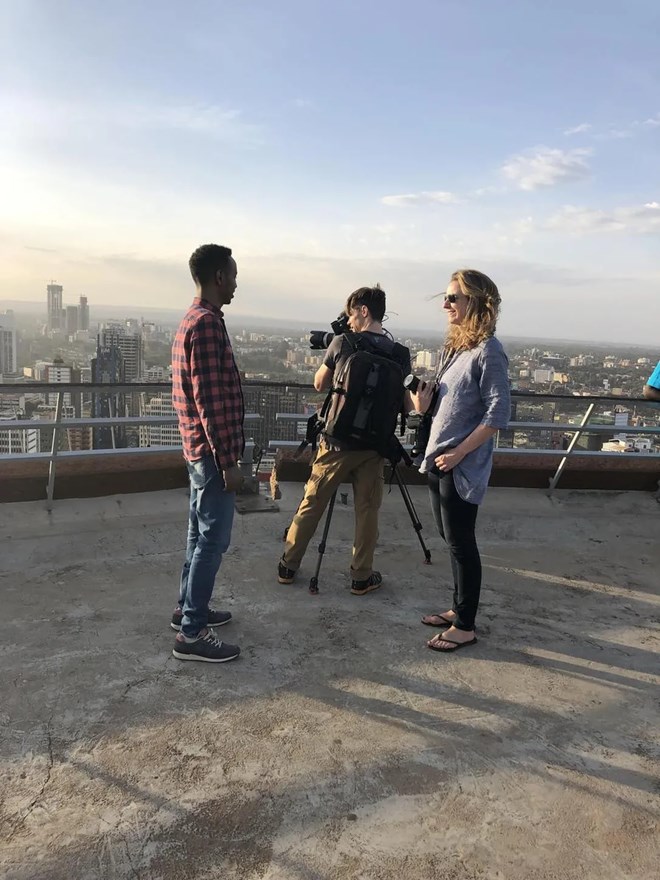
Saturday September 24, 2022
By Michelle Shephard
The whole truth about the survivor from Somalia — subject of numerous stories, a global rescue campaign, and soon a documentary — turned out to be complicated
The Perfect Story (Trailer 02m00s) from NFB/marketing on Vimeo
When I first met Ismael Abdulle in 2010, he was sitting slumped on a ratty overstuffed chair, inside a cavernous ballroom in Mogadishu. Nearby, three glass chandeliers and gold curtains hung heavy, and a patio gave way to lush gardens. Ismael was 17 years old at the time, but he could have passed for 12 or 13.
The ballroom was in the government compound known as Villa Somalia, and I was there because the new communications director for the office of Somalia’s president, Abdirashid Hashi, had introduced Ismael to me. Hashi was a former Toronto-based journalist I knew, who had moved back to Mogadishu. In recent months, al-Shabab, the Somalia-based group that would later go on to join al-Qaida, had been back in the news again. “People don’t understand how ruthless they are,” Hashi had written in an email. He said he had a story for me if I could get there.
In the ballroom Ismael sat beside two other young men, and at first, they appeared equal parts scared and confused, looking upon this dishevelled foreigner in Blundstone boots, a flak jacket and helmet. The gear was given to me by my escorts from the African Union (AU), a 5,300-strong force of Ugandan and Burundi peacekeepers, who provided security for the transitional government. They had control of the area around Mogadishu’s airport, and Villa Somalia, but everything else was al-Shabab territory, or at least had a worrying presence of their supporters.
This was not an ideal way to report, but it was hard to travel safely at that time, without being “embedded” with the AU. We drove around Mogadishu in a convoy of armoured vehicles, looking like a deranged caterpillar crawling through the city.
Through a Somali translator, I asked the boys if we could go toward the window, where the light was better. Ismael jumped up first and grabbed a red chair. Then he crossed his amputated calf over his right knee and stared into the lens with such an intensely desperate expression I had to wipe away tears along with my sweat as I steadied the camera. He was missing both his left foot and his right hand.
Ismael told me his story. He spoke fast and the translator had trouble keeping up. He said he lived in a Shabab neighbourhood but was able to attend school every day. Six months earlier, he had been stopped by two members of al-Shabab who tried to recruit him as he was heading to class.
Joining was not uncommon at the time for Somali boys with few options. Rarely was it driven by ideological or religious conviction; they were drawn by money, or protection. But Ismael told me he refused because he wanted to stay in school.
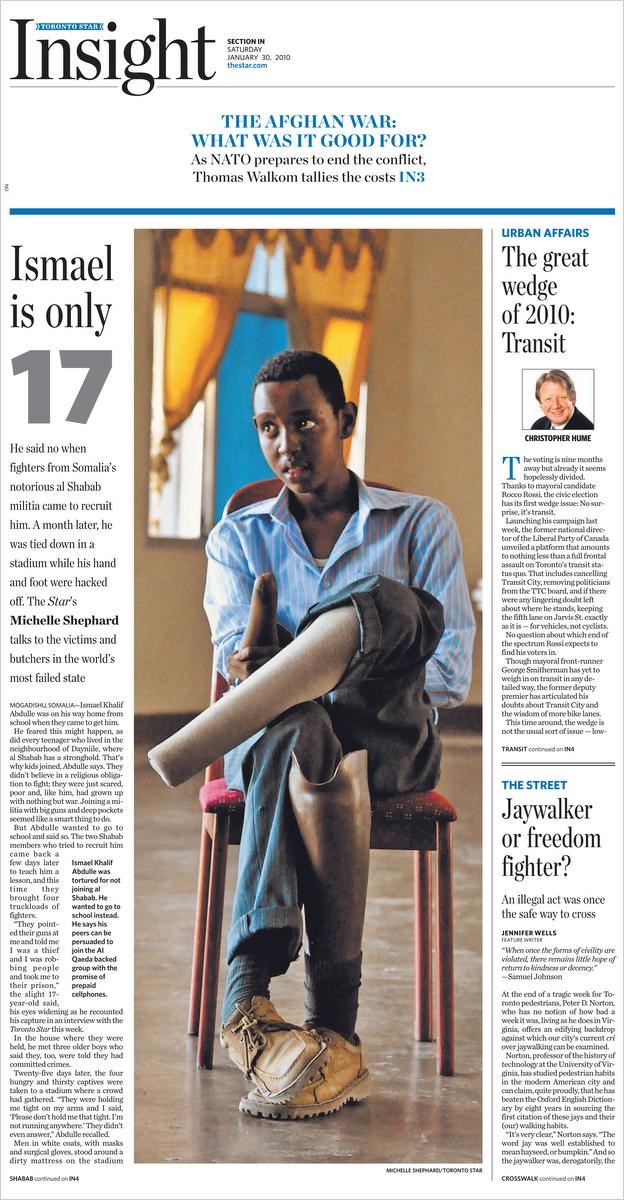
A few days later, a couple of al-Shabab members returned: “They pointed their guns at me and told me I was a thief, and I was robbing people and took me to their prison,” he said. For the next 25 days, he told me, he suffered in the prison with little food or water. On the morning of July 25, 2009, he was driven to a stadium with the two boys beside him in the ballroom, and a fourth young man. One by one, they were pinned down as men in white coats and surgical gloves sawed off their right hands and then, as they passed out with pain, their left feet. A crowd looked on. Their limbs later hung in the centre of the city as a lesson to others.
Ismael wanted my help. He begged me to take him with me.
We had been talking for no more than an hour and a half when the AU escorts decided they’d had enough. The sun was setting, we had a curfew and they made it clear they were leaving, with, or without me. Ismael looked panicked as I walked away. I had more questions, but they’d have to wait. Reluctantly, I climbed back into the safety of the caterpillar’s belly and crawled off.
There were a few constants in my years of covering conflict zones as the Toronto Star’s national security correspondent. There was always a persistent stray cat, an oblivious donkey or two, and bursts of blooming bougainvillea in an otherwise dusty terrain. They were little touchstones of familiarity in war-torn places where nothing seemed familiar.
As the years went on, cynicism became a constant companion too. It was a hard thing to deflect on my beat, where concerns about security can be exploited by those in power. Somalia was especially misunderstood. There were Somali “experts” who had never set foot in the country, and lots of “run and gun”-style journalism or filmmaking. In much of the Western consciousness, the country had never moved beyond some Hollywood depiction of “Black Hawk Down,” or “Captain Phillips.”
In reality, the country was a complicated geopolitical morass. As the New York Times’ Jeffery Gettleman once wrote, Somalia was the “graveyard for foreign-policy blunders.”
I tried to unpack all that in my reporting, but also to cover as many positive stories as I could — to celebrate the entrepreneurs, the peacemakers, the people helping the recovery. Ismael’s story was one of dozens of stories I wrote from there, and it was probably the easiest. Here was a young survivor — a photogenic, articulate aspiring student who personified goodness and bravery in the face of terrorism.
The story of Ismael Khalif Abdulle (he has since dropped the middle name) ran as part of a feature on victims and perpetrators in Somalia’s civil war. It was the cover of the Star’s Insight Section in January 2010, with his heart-wrenching photo filling the front page. The headline read: “Ismael is only 17.”
At the time, I had no idea the impact that story would have on Ismael’s life, or mine. As with so many people I’ve interviewed abroad, I figured I might never see him again. But the reaction was immediate, and the consequences continue to unfold today.
Long-time Star readers may remember what happened next. Touched by Ismael’s courage, Toronto’s powerful Somali diaspora rallied behind him and formed a group called “Project Ismael.” With help from immigration activists and refugee lawyers, they raised money and worked to get him to safety. I had dozens of calls from readers, asking how they could help.
Soon, Ismael’s story was everywhere. Gettleman included him in an article for the New York Times, and he was featured in the Guardian, and other European and American newspapers and TV outlets. A good friend of mine, Sahal Abdulle (no relation to Ismael), contacted me from Nairobi. I’ll never forget his words. “I can’t save Somalia,” he said. “But I think can save Ismael.”
Sahal was Canadian but originally from Somalia, a Reuters photojournalist weary from covering the civil war in his birth country. He threw all his energy into rescuing Ismael. Nine months later, Sahal had managed to help Ismael escape, and I flew back to Nairobi to report on him again. He was safer there, but Kenya still posed a risk because of al-Shabab.
Just three months later, Norway accepted Ismael as a refugee in immediate need. And in January 2011, Sahal, Ismael and I flew together to the city of Harstad, 200 kilometres north of the Arctic Circle. I tried to capture a photo of the two of them under the Northern Lights, but we all kept laughing and talking, and finally gave up after nearly freezing on the edge of a fiord. When I wrote my followup story, a photo of a grinning Ismael in a toque, the snowy mountains behind him, hands plunged into a ski jacket I’d brought from Canada, ran on the front page.
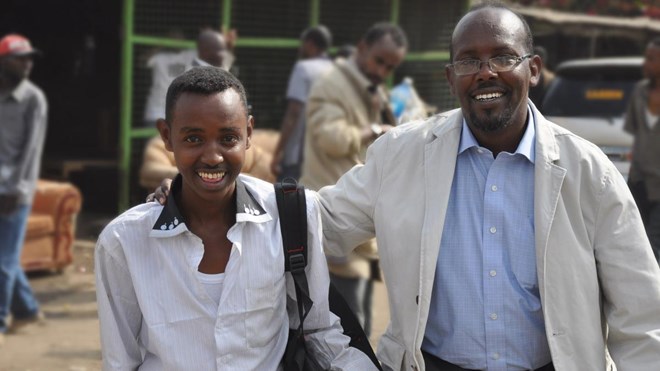
Ismael (L) and Sahal (R). Toronto Star
It was a fairy-tale ending to a tragic tale.
Everyone loves a fairy tale.
Over the years I kept in touch with Ismael in texts, calls, and emails, sending updates and funny videos. We had become friends — or as good friends as we could, countries, cultures, and years in age apart. I also visited him periodically in Harstad to write followups on his story for the Star, and I dedicated a book I wrote about national security reporting to him.
During one trip, we met in Oslo, where I was screening my film about former Canadian Guantanamo detainee Omar Khadr. That’s when Ismael asked if I would make a documentary about him, too. I didn’t need much persuading. Ismael’s story was one of my favourites from my time at the Star.
Our first filming trip in the spring of 2018 was a joyous one, as Ismael was finally becoming a Norwegian citizen. He was captivating on camera, as funny, smart, fiercely determined and boyishly charming as he was in person. He sang the Norwegian national anthem. He graciously accepted his red passport.
But soon after we left, Ismael suffered a breakdown. Our calls and texts became strained, and it was hard to figure out what was going on with him. I worried our filming — which also included a detailed recounting of the horror he faced in 2009 — had triggered his PTSD. When we filmed that scene, it was the first time I had ever seen him cry.
We delayed the documentary and I travelled again to Harstad in September 2018 to visit him alone. We spent the weekend walking the city, sipping overpriced coffee or tea and talking, or just sitting together laughing, watching movies and a lot of episodes of Jerry Seinfeld’s “Comedians in Cars.” He insisted he was ready to start filming again, and he did seem stronger.
We resumed shooting, and three months later, we flew him to Toronto to meet the members of “Project Ismael.” The next chapter was the trip to Somalia. That was going to be a big part of the film — his return home.
Seeing the excitement on Ismael’s face as we landed in Mogadishu in April 2019 elicited some conflicting emotions for me. It wasn’t lost on me that I was returning him to the place that I had a decade earlier, in a small way, helped him escape. And as we left the airport, the weight of the shifting dynamics between us became oppressive. It was easy when we were in Norway, his adopted home, or Toronto. Here we travelled in an armoured car and he stayed with us in a fortified hotel with a clientele of only wealthy Somalis, or foreigners — places that would have been alien to him a decade earlier.
Mogadishu today is nothing like the city I visited in the mid-2000s. It’s vibrant and thriving and on the road to recovery. But foreigners are still rare and targets for al-Shabab, and we had security because we could afford it.
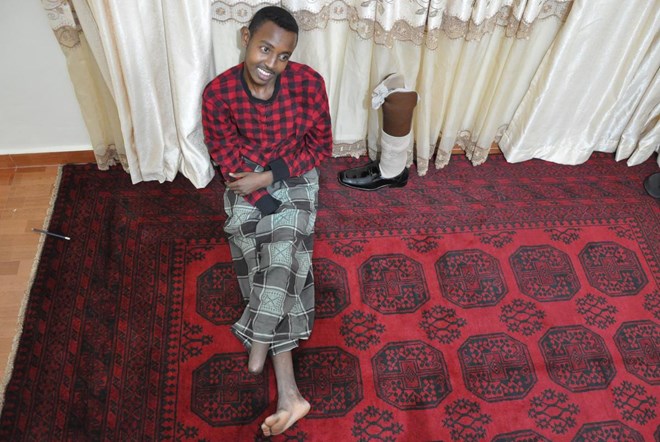
Ismael in Kenya. Toronto Star
Making a documentary is also different from daily journalism in ways not often discussed. Ismael was back in Mogadishu because we had paid for him to get there and given him a per diem for our days filming. There was a new layer of transaction, and we were now not only part of his story; we were helping shape it.
That filming week was unlike any of my past reporting trips. For one, I was unaccustomed to travelling with a crew in Somalia. It was a small group, just a sound recordist and cinematographer, plus Ismael, but every time we stepped on the street, we drew a crowd. Suddenly it felt almost ghoulish to have three white filmmakers follow Ismael around, making him articulate his every thought in real time.
We filmed for a week. After that, Ismael would stay on an extra week to visit family and friends. No one thought it was safe for him to stay longer since he was so high-profile, and he had defied al-Shabab, so he could still be a target. By the time we packed up, everyone’s nerves were frayed. Ismael was already talking about extending his visit even longer, and he started confessing to us how hard life had been in Norway, talking about the loneliness, the isolation, the racism he had faced.
We hugged as he left our hotel, the camera rolling.
Ismael’s extra week turned into two, then three, then a month, and then two. We kept changing the date for his flight back to Norway, and his texts were becoming hard to decipher. Back in Toronto, I worried that he was suffering another breakdown.
Finally, after a long silence, he said he was ready to leave. Our plan had been to meet in Amsterdam before filming his last leg home to Norway. But Ismael sent a text saying he had disappointing news to tell me, and I should come to Amsterdam first, just to talk.
In June 2019, I met Ismael in Amsterdam with producer Bryn Hughes, and no recording equipment. That’s when he first said: “I haven’t told the truth.”
What happened next plays out in dramatic detail in the film — but it’s here, in the Star, where Ismael’s story first became public, that I need to correct the record first.
Ismael Abdulle wasn’t exactly who he had told me he was that day we first met. He told me now what had really happened. Al-Shabab had indeed kidnapped him, but not because he had resisted their recruitment. Instead, Ismael was trying to rob people at the local market when a couple of al-Shabab members came up and asked if they could see his gun. He gave it to them; they turned it on him, and said he was a thief and would be punished.
The broad strokes of the rest of his story remain the same. He was held in a prison. He was maimed by members of al-Shabab. There are horrible photos of Ismael in that stadium just before he had his hand and foot cut were off. There is a photo of his severed limbs hanging in the city square.
But he didn’t later escape his captivity by duping his captors, as he had claimed. The Shabab leaders had instead returned him home after he was punished.
In short, some of the heroic details in his story, which I had reported in this paper in 2010, and again for many years later, were false.
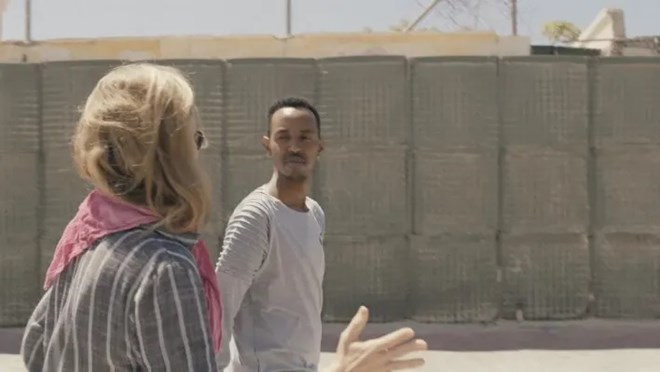
Ismael Abdulle is interviewed in April 2019, in Mogadishu in a scene from Michelle Shephard’s soon to be released doc, “The Perfect Story.” NFB
At first, Bryn and I didn’t know what to say. I think I thanked him for telling us the truth. He left for Norway the next day, and we agreed to talk later about the film.
In the coming days and weeks I tried to think back to our first meeting 10 years earlier, wondering if I had done my due diligence in reporting his story. I remember questioning him as gently as I could, which I would do with any victims of war, doing my best not to re-traumatize them.
I confirmed with photos and local reports that it was al-Shabab members who had cut off his hand and foot in a stadium, but there was the logistical reality of reporting in a conflict zone. I wasn’t able to travel to his neighbourhood to interview those who knew him. Once I left Somalia, the day after, I did the rest of my interviewing by phone through Hashi, and other contacts.
No one raised any questions about the veracity of his claims, with one exception: al-Shabab. The group had quite an active media wing, which confirmed the amputations but claimed they were punishment for theft. I had debunked al-Shabab propaganda in the past, including in a story where I travelled to the Dadaab refugee camp in Kenya to track down the family of a 13-year-old girl they had stoned to death; al-Shabab had claimed she was 20 and that she welcomed the stoning as fair punishment for her alleged adultery.
My years of security reporting had honed my skepticism. I approached interviews presuming most people had an agenda, and I pushed back hard on those in positions of power. There are countless examples of narratives spun by governments that have had disastrous consequences, even leading countries into war.
But I didn’t question those details in Ismael’s claims.
If I felt disappointed at him, or angry at myself, those feelings were complicated by another sense. The more I thought about his lies, the more I was struck by Ismael’s intelligence and savvy. He knew his life would be difficult as a double amputee in Mogadishu. He was desperate. Although he was just a teenager, he also figured no one would help him if he said he had been caught trying to steal money. So he concocted a perfect narrative as Ismael the defiant student.
His story worked for Hashi, and the government forces who took him in. His story worked for me. And his story worked for our readers, too.
The fuller truth is that the gap between what happened and what Ismael first told me wasn’t that wide. He was only 17. And he had been imprisoned and physically mutilated. At its base, his story is still a story of a young man whose life took a tragic turn because of brutal fundamentalists.
What widened that gap was what happened when my newspaper story amplified his story, and when it got picked up by the global media. Once he became a “hero,” there was no turning back. He had to keep telling the story. Again, and again and again.
Yes, he had told the original falsehood, but my stories, and the ones that followed, held him there.
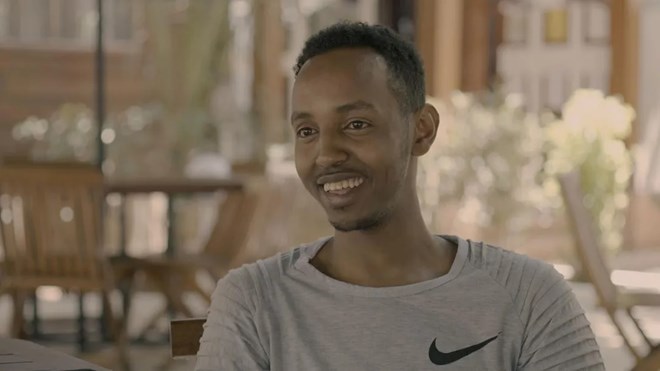
Ismael Abdulle is interviewed in April 2019, in Mogadishu in a scene from Michelle Shephard’s soon to be released doc, “The Perfect Story.” NFB
Once I returned to Toronto, I just felt a profound sadness. Sad that Ismael had to carry this wound, along with so many others he endured. Sad that I had played a part. Was it PTSD Ismael suffered in those breakdowns, or guilt about the lies he told me, or some inseparable mix of the two?
If I’d known the truth, I like to think I still would have written about Ismael. He deserved all the attention, empathy, and support he received. But would his story have had such an impact if all the details were known? Would the public have loved him the same way?
CBC journalist Duncan McCue coined a phrase recently about journalists needing to be “storytellers, not story takers.” He was referring to the colonial lens and Canada’s ongoing reckoning with how Indigenous stories have been told. But Ismael’s story made me confront this phrase. It’s not just his tale I’ve found myself reflecting on. What about so many other stories I told as a foreign correspondent? Had I been a story taker?
There’s no doubt journalists all tell stories through their own lens. We make choices, consciously and unconsciously. The day I met Ismael I told only his story, although two others in the same room had been maimed by al-Shabab alongside him, and there were countless other victims. Why? A common phrase in journalism is to “bear witness.” But we do more than that.
Over the years, I prided myself on tackling security stories that were complicated, and sometimes unpopular. I had to plead with editors to keep covering the Omar Khadr saga. Never fitting into a tidy narrative, his case touched on the many ways the West had lost perspective in the aftermath of the Sept. 11 attacks. It took a long time for those articles about Khadr and Guantanamo to move from the back pages to the front.
When I met Ismael, I had already been reporting on security issues for a decade. And yet there was no question I was drawn to his Hollywood-friendly narrative. He was the perfect victim. It was the perfect story.
And what about agency? How did the lines of our relationship blur? It’s uncommon, and in fact frowned-upon, to have a long-standing friendship with someone you have covered. It can interfere with supposed objectivity — and not just the journalist’s. Ismael later said there were times he would just tell me what he thought I wanted to hear.
Ismael eventually agreed to keep filming, to tell us the full story, on camera. In our often xenophobic, post-truth world, that’s an incredibly brave act. And once we were done, he watched the film. He said he understands why it needs to come out, though he wants nothing more than to put it all behind him and move on.
I will be eternally grateful that he told a difficult truth and allowed us to finish his story. But I’m cognizant of the fact that I’m still the one telling it, and that I remain as much a part of it as I ever was.
The simple narrative was complicated after all. When is it ever not?
